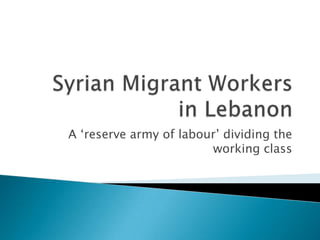
Confirmation seminar
- 1. A ‘reserve army of labour’ dividing the working class
- 2. The study will concentrate on exploring: ◦ phenomenon of Syrian labour migration into Lebanon ◦ The labour market position of Syrian migrant workers in Lebanon, are they part of the primary labour market or are they the part of the ‘reserve army of labour’ ◦ The relationship of these workers with the overall market, are they part of the overall working class?
- 3. Migration overview- Guest workers Marxist literature ◦ Marx’ s labour market theories- Industrial reserve army and its relation to capital ◦ Modern Marxists migration literature- applying the ‘reserve army of labour’ theory to migrant workers in Europe Dualist theory literature ◦ Labour market segmentation theory
- 4. Eastern European guest workers in UK South Asian guest workers in the Gulf Mexican workers in the US Migrant workers in Hong Kong Guest workers in Australia Syrian migrant workers in Lebanon
- 5. Brief history of the phenomenon Literature dealing with Syrian migrant workers in Lebanon Syrian workers are victims of external factors as much they are victims of their work- related factors Concentration of Syrian workers in terms of industries- Over 70% of them work in the construction industry
- 6. The research will concentrate mainly on Syrian migrant workers in the construction industry The research will canvass the opinions of: ◦ Lebanese union officials ◦ Lebanese government officials ◦ Lebanese construction companies management ◦ Lebanese construction workers
- 7. Do Syrian migrant workers constitute a reserve army of labour which is readily available for exploitation by Lebanese capital? Given the precarious nature of their jobs and the sectors they work in, what is the position of Syrian migrant workers in the Lebanese labour market? Are these migrant workers unwittingly dividing the Lebanese labour market and creating a ‘dual labour market’ consisting of a primary labour force consisting mainly of Lebanese workers and a secondary labour market consisting primarily of migrant workers? Do Lebanese workers believe Syrian migrant workers are undercutting their wages, conditions and stealing their jobs?
- 8. Do Lebanese unions officials believe that Syrian workers are splitting the working class in Lebanon? What policies these unions are putting together to deal with the situation? How do they feel about this cycle of exploitation presumably perpetuating a divided working class too weak to fight for better conditions and higher pay?
